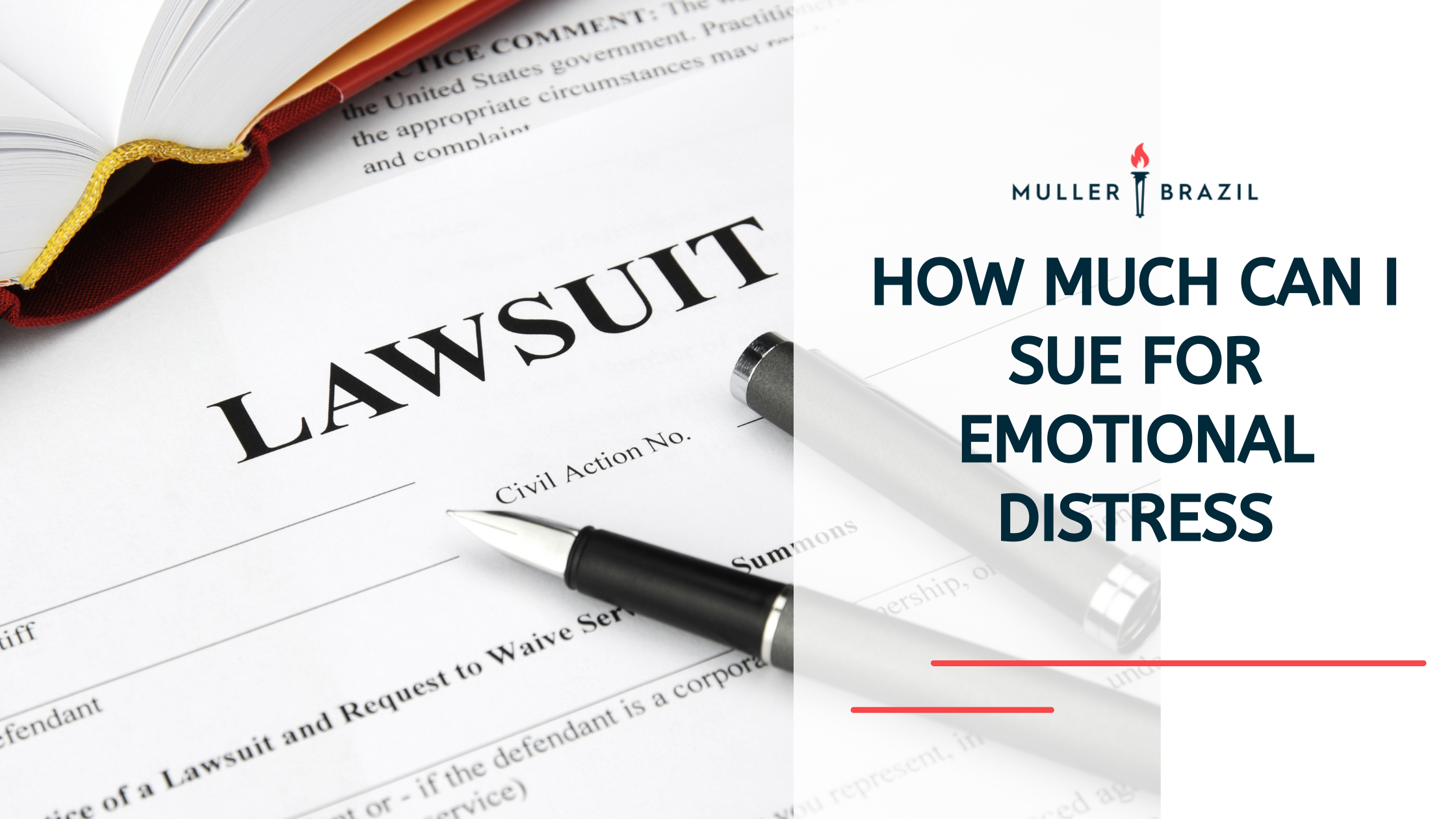7 min read
How Much Can I Sue for Emotional Distress
![]() Maximillian J. Muller, Esquire
Jan 16, 2025 11:18:00 AM
Maximillian J. Muller, Esquire
Jan 16, 2025 11:18:00 AM
Emotional distress can have a lasting impact on a person's mental and emotional well-being. It often stems from traumatic events, such as serious accidents, wrongful death, or intentional actions that cause harm.
In personal injury law, emotional distress claims provide a path for victims to seek compensation for the psychological injuries they've suffered.
While emotional distress is not always visible, its effects are real and can disrupt daily life, work, and relationships. Emotional distress claims can result in substantial compensation, depending on the severity of the trauma and its impact. Settlements for severe emotional distress have ranged from tens of thousands to millions of dollars.
Dillon v. Legg (1968)
In this pivotal case, a mother witnessed the tragic death of her child in a car accident caused by a negligent driver. Though she was not physically harmed, the court ruled that the emotional trauma she suffered was enough to seek damages.
Understanding emotional distress claims is the first step in recovering compensation for emotional suffering. This guide will break down the types of claims, legal requirements, and what it takes to prove emotional distress in court.
What Is Emotional Distress?
Emotional distress refers to the psychological impact caused by someone else’s actions, whether intentional or negligent. It is often classified as mental suffering, emotional turmoil, or psychological injury that affects a person’s emotional well-being and quality of life.
While emotional distress is not always tied to physical injuries, it can lead to symptoms such as:
- Severe anxiety and panic attacks
- Depression and feelings of hopelessness
- Post-traumatic stress disorder (PTSD)
- Sleep disturbances or nightmares
- Physical symptoms like headaches, stomach issues, or muscle tension
According to the American Psychological Association (APA), prolonged emotional trauma can lead to serious mental health conditions requiring medical treatment and therapy.
Emotional distress is often recognized in personal injury cases, especially when it arises from:
- A serious accident like a car crash or workplace injury
- Wrongful death of a loved one
- Intentional acts, such as harassment, assault, or defamation
- Negligent actions, including failure to prevent harm
Understanding emotional distress claims allows victims to recognize their legal rights and take steps toward recovering compensation for their suffering.
Get Help Today
Types of Emotional Distress Claims
Emotional distress claims generally fall into two categories, intentional infliction and negligent infliction of emotional distress. Each type has different legal standards and requirements for proving emotional harm.
Intentional Infliction of Emotional Distress (IIED)
- This claim applies when someone deliberately causes severe emotional distress through outrageous behavior.
- Examples include threats, harassment, or acts of extreme negligence that are meant to harm.
- To win this type of claim, you must show that the defendant’s actions were intentional and reckless, resulting in emotional turmoil and mental suffering.
-
Snyder v. Phelps (2011)
- The family of a U.S. Marine sued members of the Westboro Baptist Church for emotional distress after they picketed his funeral with offensive messages. Although the family’s emotional suffering was undeniable, the court ruled in favor of the defendants due to First Amendment protections. No damages were awarded, but similar emotional distress claims, when successful, can secure settlements of $50,000 to $200,000.
Negligent Infliction of Emotional Distress (NIED)
- This claim occurs when someone’s negligent actions unintentionally cause emotional distress.
- For example, witnessing a serious accident involving a loved one or being involved in a traumatic event can lead to psychological injury.
- Plaintiffs must prove emotional distress by showing that the defendant’s conduct failed to meet a reasonable standard of care and caused severe harm.
- A man suffered severe emotional distress after his wife was falsely diagnosed with a sexually transmitted disease, which strained their marriage and caused psychological harm. The court awarded him damages for his suffering. Cases involving severe medical negligence and emotional harm often result in payouts of $250,000 to $1 million, depending on the impact on the victim’s life.
Common Examples of Emotional Distress Cases
- Car accidents resulting in physical injury and emotional trauma
- Workplace harassment or bullying leading to mental anguish
- Wrongful death claims causing severe anxiety and grief
- Defamation cases that damage reputation and cause emotional turmoil
Many victims of emotional distress cases experience ongoing challenges such as difficulty maintaining relationships, reduced ability to work, and the need for medical treatment from mental health professionals. These factors often strengthen claims for emotional distress damages.
Typical Compensation Ranges
- Mild Emotional Distress (e.g., anxiety from a minor accident): $5,000 to $25,000
- Moderate Emotional Distress (e.g., depression requiring therapy): $25,000 to $100,000
- Severe Emotional Distress (e.g., PTSD or inability to work): $100,000 to $1,000,000+
- High-Profile or Complex Cases (e.g., wrongful death, large-scale negligence): $1 million to $10 million or more
Realistic Claims Examples
- Bystander Emotional Trauma: Witnessing a loved one’s death, as in Dillon v. Legg, can lead to settlements between $100,000 and $500,000.
- Medical Negligence: Severe psychological harm due to medical malpractice, like in Molien v. Kaiser Foundation, may result in payouts ranging from $250,000 to $1 million.
- Industrial or Workplace Negligence: Cases involving large-scale trauma, such as the Kentucky plant explosion, can see total settlements reaching $10 million or higher if many victims are affected.
Contact Us Now
When Can You Sue for Emotional Distress?
You can sue for emotional distress when someone else’s actions, either intentional or negligent, cause severe emotional harm or mental suffering. However, proving a valid claim requires meeting specific legal standards.
Requirements for an Emotional Distress Lawsuit
To claim emotional distress in court, you must show:
The Defendant’s Conduct Caused Harm
- The defendant’s actions must be intentional or negligent and directly responsible for your emotional suffering.
Severe Emotional Distress
- The distress must go beyond minor discomfort, resulting in emotional turmoil, panic attacks, or physical symptoms such as stomach issues or insomnia.
Proof of Impact
- You need evidence, such as medical records, mental health evaluations, or witness testimony, to prove emotional distress and its effects on your daily life.
Situations That Support a Lawsuit
- Serious Accidents – Car crashes, falls, or workplace incidents leading to emotional trauma.
- Wrongful Death – Losing a loved one due to someone else’s negligence.
- Intentional Acts – Harassment, abuse, or intentional infliction of harm.
- Extreme Negligence – Failure to prevent a dangerous situation causing severe anxiety and mental anguish.
Filing Without a Physical Injury
While physical injury can strengthen an emotional distress claim, it is not always required. For example:
- Intentional Infliction claims often focus entirely on psychological injury caused by outrageous intentional actions.
- Negligent Infliction claims may still succeed if the emotional harm is severe and well-documented.
The Role of Mental Health Professionals
Evaluations by mental health experts can support your case by documenting:
- Symptoms of post-traumatic stress disorder (PTSD), severe anxiety, or depression.
- The need for medical treatment, therapy, or medication.
- The overall impact on your mental state and emotional well-being.
Proving Emotional Distress in Court
Proving emotional distress in court can be challenging since it often lacks visible signs like physical injuries. However, strong evidence can demonstrate the impact of emotional suffering and justify fair compensation.
Evidence to Prove Emotional Distress
Medical Records and Treatment Documentation
- Records from mental health professionals showing diagnoses of PTSD, severe anxiety, or depression.
- Evidence of medical treatment, such as therapy sessions, medications, or counseling for emotional trauma.
Witness Testimony
- Statements from family members, friends, or co-workers describing changes in your mental state, daily life, or behavior after the traumatic event.
Personal Testimony
- Your own account of how the defendant’s actions caused emotional turmoil, disrupted your emotional well-being, and affected your ability to work or maintain relationships.
Physical Symptoms
Proof of physical symptoms caused by mental anguish, such as:
- Headaches
- Stomach issues
- Insomnia
- Panic attacks
Expert Opinions
- Reports from mental health experts supporting the psychological impact of the incident and validating the severity of your emotional distress.
The Impact Rule in Emotional Distress Cases
Some states follow the impact rule, which requires plaintiffs to show a physical injury or contact alongside emotional trauma. However, many courts allow claims without physical harm, especially in cases involving:
- Intentional infliction of harm.
- Extreme negligence resulting in severe mental anguish.
Strengthening Your Case
To build a solid emotional distress lawsuit, you should:
- Keep records of medical bills, therapy costs, and lost wages.
- Document changes in your daily life, relationships, and emotional well-being.
- Work with an experienced attorney to gather evidence and claim compensation for emotional distress damages.
Types of Damages Awarded
When filing an emotional distress lawsuit, victims may be eligible for several types of damages based on the severity of their emotional suffering and the defendant’s conduct. These damages aim to help victims recover compensation for both financial losses and personal hardships.
1. Compensatory Damages
Compensatory damages cover the tangible costs associated with emotional distress, including:
- Medical bills for therapy, counseling, and mental health treatment.
- Lost wages due to missed work caused by mental anguish or the inability to perform job duties.
- Physical pain and discomfort tied to emotional turmoil and physical symptoms, such as stomach issues or headaches.
2. Non-Economic Damages
Non-economic damages address emotional suffering and the personal impact of psychological injury on a victim’s life. These may include:
- Pain and suffering related to emotional trauma and mental distress.
- Loss of enjoyment of life, such as an inability to participate in hobbies or maintain relationships.
- Loss of companionship, especially for family members dealing with wrongful death cases.
3. Punitive Damages
In cases involving intentional infliction of harm or extreme negligence, courts may award punitive damages. These are meant to punish the defendant’s actions and deter similar behavior in the future.
What Factors Affect Compensation?
Several factors influence the potential compensation awarded in emotional distress cases, including:
- The severity of emotional harm and mental suffering caused.
- Whether the defendant’s conduct was intentional or negligent.
- The impact on the victim’s daily life, relationships, and emotional well-being.
- Supporting evidence, such as medical records, witness testimony, and evaluations by mental health professionals.
Seeking Help from an Emotional Distress Lawyer
Emotional distress can have lasting effects on your mental health, emotional well-being, and daily life. Whether caused by a serious accident, wrongful death, or intentional actions, victims deserve fair compensation for the emotional suffering they’ve endured.
Filing an emotional distress lawsuit may help you recover compensation for medical bills, lost wages, and non-economic damages like pain and suffering. Working with mental health professionals and gathering strong evidence, such as medical records and witness testimony, can strengthen your case and support your claim for substantial compensation.
Contact Muller Brazil for Help Today
If you’ve suffered emotional distress due to someone else’s negligence or intentional infliction of harm, the attorneys at Muller Brazil can help. We’re dedicated to helping injury victims build strong cases and seek compensation for their losses.
Get a free consultation today! Let us help you prove your case and pursue the emotional distress damages you deserve. Contact Muller Brazil now learn more about how we can help you take the next step toward justice.
Meet the Author
Max Muller - Founding Partner
Maximillian J. Muller is a founding member of Muller Brazil and My Vaccine Lawyer. Mr. Muller is an experienced litigator in both Federal and State Courts in the areas of vaccine injury, unsafe drug and medical device injury, personal injury, mass torts, and bad faith. Mr. Muller prides himself on keeping Muller Brazil on the cutting edge of injury litigation and running a client-focused practice.
Learn more about Max Muller ⇒





